| Srl | Item |
| 1 |
ID:
083697
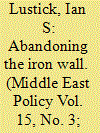

|
|
|
| 2 |
ID:
121484
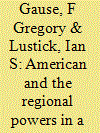

|
|
|
| 3 |
ID:
156855
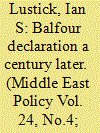

|
|
|
|
|
| Summary/Abstract |
The 2017 centennial of the Balfour Declaration has been observed with great fanfare. The theme of the 2017 annual meeting of the Association for Israel Studies was “A Century after Balfour: Vision and Reality.” In February 2017, Israeli Prime Minister Benjamin Netanyahu exulted in the British government's invitation to him to attend its celebration of the centenary: “While the Palestinians want to sue Britain for the Balfour Declaration, the British prime minister is inviting the Israeli prime minister to an event to mark the hundredth anniversary of the declaration. That speaks volumes.” Israel reciprocated by inviting the royal family to visit the Jewish state to honor the anniversary of the declaration.
|
|
|
|
|
|
|
|
|
|
|
|
|
|
|
|
| 4 |
ID:
183257
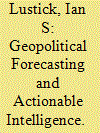

|
|
|
|
|
| Summary/Abstract |
In geopolitics, even rough probabilistic forecasts are difficult to make. Scenario design, table-top simulations and structured discussions are heuristic activities that focus the attention of analysts and increase policymaker satisfaction with intelligence products, but their usefulness is not based on confidence that forecasts are accurate. Traumatised by 9/11 and encouraged by advances in social science, computerised data collection and artificial intelligence, the US government has greatly increased investments in reliable geopolitical forecasting. Despite progress by using computerised data processing, sophisticated statistical methods and machine learning, the results have so far been of limited practical assistance. Forecasters must not only provide credible probability judgements but also show the causal pathways underlying them to enable policymakers to mitigate harms and exploit opportunities. Building that capacity means enhancing the role of social scientists in the design and testing of computer simulation and other forecasting techniques.
|
|
|
|
|
|
|
|
|
|
|
|
|
|
|
|
| 5 |
ID:
084346


|
|
|
|
|
| Publication |
2008.
|
| Summary/Abstract |
A nuclear Iran may not be the biggest threat to Israel. Fear is a danger in and of itself. Until now, Israel has triumphed in the Middle East against overwhelming odds because of a clever, rational defense policy that used force as a last resort. If it adopts this attitude again, it can certainly withstand an atomically armed Tehran.
|
|
|
|
|
|
|
|
|
|
|
|
|
|
|
|
| 6 |
ID:
138573
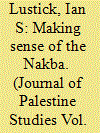

|
|
|
|
|
| Summary/Abstract |
Zionist claims to rightful rule of most or all of Palestine/the Land of Israel ultimately depend on naturalizing those claims into common sense, for Jews, of course, but also for the international community. Following the 1967 war, Israelis in favor of withdrawing from occupied territories have relied on distinguishing between the justice of the 1949 Armistice Lines, and the process that led to the State of Israel within those lines, versus the injustice of the occupation of territories conquered in 1967 and of their settlement and gradual absorption. But as the truth of the expulsions and forced dispossession of Palestinians in 1948 becomes accepted by wider swaths of both Israeli-Jewish and international public opinion, the traditional narrative distinguishing the justice of 1948 and the injustice of 1967 breaks down. Ari Shavit’s book, My Promised Land, can be understood as a response by Israeli two-staters to accusations of hypocrisy by the extreme right.
|
|
|
|
|
|
|
|
|
|
|
|
|
|
|
|
| 7 |
ID:
175426
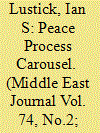

|
|
|
|
|
| Summary/Abstract |
More than 50 years of American diplomacy in the Arab-Israeli “peace process” have revealed it to be a carousel of constant activity with no forward movement. Despite chronic failure and embarrassment, it continues in great measure because of the cumulative effects of the influence of the Israel lobby in the United States, through cycles of opportunity, initiative, retreat, and compensation. Mathematician John Nash’s theory of an inefficient equilibrium is offered as an explanation for the still-sustained pretense of the possibility of a negotiated peace agreement and the conditions under which the peace process carousel could finally stop turning.
|
|
|
|
|
|
|
|
|
|
|
|
|
|
|
|
| 8 |
ID:
167918
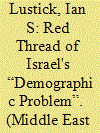

|
|
|
|
|
| Summary/Abstract |
In the spring and early summer of 2018, Israeli forces shot or gassed more than 16,000 people. The ferocity of this response to the massing of Palestinians near the barrier surrounding the Gaza Strip is striking but not astonishing. It reflects a fundamental truth and springs from a deep fear. The truth is that the essential aspiration of the late nineteenth and early twentieth century architects of the Zionist movement was to ensure that somewhere in the world — and that place came to be Palestine — there would be a majority of Jews. The fear is of Jews losing the majority they achieved.
|
|
|
|
|
|
|
|
|
|
|
|
|
|
|
|
| 9 |
ID:
053133
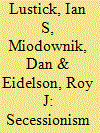

|
|
|
| 10 |
ID:
075177


|
|
|
|
|
| Publication |
Philadelphia, University of Pennsylvania Press, 2006.
|
| Description |
xii, 186p.
|
| Standard Number |
0812239830
|
|
|
|
|
|
|
|
|
|
|
|
Copies: C:1/I:0,R:0,Q:0
Circulation
| Accession# | Call# | Current Location | Status | Policy | Location |
| 051924 | 363.3250973/LUS 051924 | Main | On Shelf | General | |
|
|
|
|
| 11 |
ID:
121475
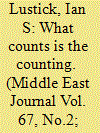

|
|
|
|
|
| Publication |
2013.
|
| Summary/Abstract |
Seven years ago, heightened anxieties in Israel about an Arab threat to Israel's Jewish majority triggered an influential campaign to change perceptions of who is winning the demographic battle. Proposals to annex 60% or more of the West Bank are based in part on its success in persuading many Israelis and others of the nonexistence of 1 to 1.5 million "missing" Palestinians. This campaign's estimates of Arab and Jewish population for 2004 and beyond are subjected to close scrutiny, revealing complex but systematic manipulation of data and exposing the political objectives and drastic distortions of the campaign.
|
|
|
|
|
|
|
|
|
|
|
|
|
|
|
|